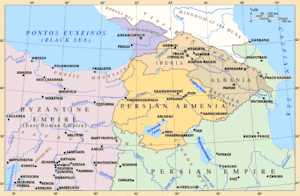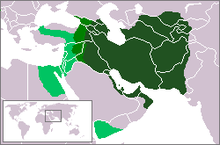Albania (satrapy)
Albania, or Ardhan in Parthian or Arran in Middle Persian, was a Caucasian satrapy[4][5][6][7] (province) of the Sassanid Empire.
Arran | |||||||||||
|---|---|---|---|---|---|---|---|---|---|---|---|
| 252 AD–639-643 AD | |||||||||||
 Caucasian Albania during the Sassanid Empire. | |||||||||||
| Status | Province | ||||||||||
| Capital | Kabalak, Partav | ||||||||||
| Common languages | Caucasian Albanian, Armenian, Parthian,[1] Middle Persian[2][3] | ||||||||||
| Religion | Paganism, Christianity, Zoroastrianism | ||||||||||
| Historical era | Middle Ages | ||||||||||
• Established | 252 AD | ||||||||||
• Disestablished | 639-643 AD | ||||||||||
| ISO 3166 code | AL | ||||||||||
| |||||||||||
History

In 252-253 AD Caucasian Albania, along with Caucasian Iberia and Greater Armenia, was conquered and annexed by the Sassanid Empire. Albania retained its monarchy, although the king had no real power and most civil, religious, and military authority lay with the Sassanid marzban (military governor) of the territory. In 297 the treaty of Nisibis stipulated the reestablishment of the Roman protectorate over Iberia, but Albania remained an integral part of the Sasanian Empire.[6]
In the middle of the 4th century the king of Albania, Urnayr, arrived in Armenia and was baptized by Gregory the Illuminator, but Christianity spread in Albania slowly, and the Albanian king remained loyal to the Sassanids. After the partition of Armenia between Byzantium and Persia (in 387 AD), Albania with Sassanid help was able to seize from Armenia the entire right bank of the river Kura up to the river Araxes, including Artsakh and Utik.[6]
The Sassanid king Yazdegerd II passed an edict requiring all the Christians in his empire to convert to Mazdaism, fearing that Christians might ally with Roman Empire, which had recently adopted Christianity. This led to rebellion of Albanians, along with Armenians and Iberians. However, the Albanian king Vache, a relative of Yazdegerd II, converted to the official religion of the Sassanian empire, but quickly reverted to Christianity.
In the middle of the 5th century by the order of the Persian king Peroz I Vache built in Utik the city initially called Perozabad, and later Partaw and Barda, and made it the capital of Albania.[8] The seat of the Albanian Catholicos was also transferred to Partaw,[9] as well as the marzban.[6]
After the death of Vache, Albania remained without a king for thirty years. The Sasanian Balash reestablished the Albanian monarchy by making Vachagan, son of Yazdegerd and brother of the previous king Vache, the king of Albania.
By the end of the 5th century, the ancient ruling dynasty of Albania was replaced by princes of the Persian or Parthian Mihranid family, who claimed descent from the Sasanians. They assumed a Persian title of Arranshahs (i.e. shahs of Arran, Persian name of Albania).[10] The ruling dynasty was named after its Persian founder Mihran, who was a distant relative of the Sasanians.[11] The Mihranid dynasty survived under Muslim suzerainty until 821-2.[12]
In the late 6th – early 7th centuries AD the territory of Albania became an arena of wars between Sassanian Persia, Byzantium and Khazar kaganate, the latter two very often acting as allies. During the Third Perso-Turkic War, the Khazars invaded Albania, and their leader Ziebel declared himself lord of Albania, levying a tax on merchants and the fishermen of the Kura and Araxes rivers, which was "in accordance with the land survey of the kingdom of Persia". The Albanian kings retained their rule by paying tribute to the regional powers.[13] Albania was later conquered by the Arabs during the Islamic conquest of Persia.
Politics and organization
The king of Albania was a vassal of the Sassanid empire, although the monarchy did not exercise much control. The king was accountable to the marzban, who held the real authority in civil, religious, and military power. The capital of the province was P'artaw (no connection to Parthia), where they minted coins in the 5th and 6th centuries. The Albanian court was probably modeled on the Armenian court with borrowings from Parthian Iran. Albania also had the Sassanian equivalent of a wuzurg framandar (prime minister) however what his role was is not known, but, as in Sasanian Armenia, it is possible that he was subordinate to the marzban.[6]
Cities and fortifications
P'artaw was established as the capital in the 4th century. It was later named Perozabad when Peroz rebuilt the city. The city underwent another name change with Kavad fortified the city and called it Perozkavad (victorious Kavad). At this time P'artaw was highly prosperous and a powerful stronghold sometime in the 5th century. Kabala, the former capitol, still maintained some importance, and it later became a see of a bishop. Excavations have revealed a fortress and walls, probably from the 5th or 6th centuries. Xalxal, a city situated in Uti but close to Iberia, became the winter residence of the Albanian kings. Diwatakan, also in Uti, became the summer residence.
The Sassanian kings, such as Yazdegerd II, Kavad I, and Khosrow I also built many fortifications in the Caucasus and Caspian coastline, the most famous being the one at Darband (modern day Dagestan, North Caucasus). Movses Kalantuaci speaks of "magnificent walls built at great expense by the kings of Persia."[6]
See also
References
- Toumanoff, Cyril. The Arsacids. Encyclopædia Iranica. excerpt:"Whatever the sporadic suzerainty of Rome, the country was now a part—together with Iberia (East Georgia) and (Caucasian) Albania, where other Arsacid branched reigned—of a pan-Arsacid family federation. Culturally, the predominance of Hellenism, as under the Artaxiads, was now followed by a predominance of “Iranianism,” and, symptomatically, instead of Greek, as before, Parthian became the language of the educated"
- Shnirelman, V.A.(2001), 'The value of the Past: Myths, Identity and Politics in Transcaucasia', Osaka: National Museum of Ethnology. pp 79: "Yet, even at the time of Caucasian Albania and later on, as well, the region was greatly affected by Iran and Persian enjoyed even more success than the Albanian language".
- Benjamin W. Fortson, "Indo-European Language and Culture: An Introduction", John Wiley and Sons, 2009. pg 242: " Middle Persian was the official language of the Sassanian dynasty"
- Gignoux. "Aneran". Encyclopaedia Iranica. Text: The high priest Kirder, thirty years later, gave in his inscriptions a more explicit list of the provinces of Aneran, Georgia, Albania, and Balasagan, together with Syria and Asia Minor. Archived November 16, 2007, at the Wayback Machine
- Encyclopædia Britannica:The list of provinces given in the inscription of Ka'be-ye Zardusht defines the extent of the empire under Shapur, in clockwise geographic enumeration: (1) Persis (Fars), (2) Parthia, (3) Susiana (Khuzestan), (4) Maishan (Mesene), (5) Asuristan (southern Mesopotamia), (6) Adiabene, (7) Arabistan (northern Mesopotamia), (8) Atropatene (Azerbaijan), (9) Iberia (Georgia), (10) Machelonia, (11) Albania (eastern Caucasus), (12) Balasagan up to the Caucasus Mountains and the Gate of Albania (also known as Gate of the Alans), (13) Patishkhwagar (all of the Elburz Mountains), (14) Media, (15) Hyrcania (Gorgan), (16) Margiana (Merv), (17) Aria, (19) Abarshahr, (18) Carmania (Kerman), (19) Sakastan (Sistan), (20) Turan, (21) Mokran (Makran), (22) Paratan (Paradene), (23) India (probably restricted to the Indus River delta area), (24) Kushanshahr, until as far as Peshawar and until Kashgar and (the borders of) Sogdiana and Tashkent, and (25), on the farther side of the sea, Mazun (Oman)
- Encyclopaedia Iranica Archived 2007-03-10 at the Wayback Machine
- Wiesehofer, Josef. Ancient Persia. published 1996, page 184 - Text: "And I [Shapur I] possess the lands [provinces; Greek ethne]: Fars [Persis], Pahlav [Parthia], Huzestan [Khuzistan], Meshan [Maishan, Mesene], Asorestan [Mesopotamia], Nod-Ardakhshiragan [Adiabene], Arbayestan [Arabia], Adurbadagan [Atropatene], Virozan [Iberia], Segan [Machelonia], Arran [Albania], Balasagan up to the Caucasus and to the 'gate of the Alans' and all of Padishkwar[gar] the entire Elburz chain = Tabaristan and Gelan (?), Mad [Media], Gurgan [Hyrcania], Marv [Margiana], Harey [Aria], and all of Abarshahr [all the upper (=eastern, Parthian) provinces], Kerman [Kirman], Sakastan, Turgistan, Makuran, Pardan [Paradene], Hind [Sind] and Kushanshahr all the way to Pashkibur [Peshavar?] and to the borders of Kashgaria, Sogdia and Chach [Tashken] and of the sea-coast Mazonshahr [Oman]."
- Movses Kalankatuatsi. History of Albania. Book 1, Chapter XV
- Movses Kalankatuatsi. History of Albania. Book 2, Chapter VI
- Encyclopedia Iranica. C. E. Bosworth. Arran Archived 2008-09-13 at the Wayback Machine
- Moses Kalankatuatsi. History of country of Aluank. Chapter XVII. About the tribe of Mihran, hailing from the family of Khosrow the Sassanian, who became the ruler of the country of Aluank
- The Cambridge history of Iran. 1991. ISBN 0-521-20093-8
- An Introduction to the History of the Turkic Peoples by Peter B. Golden. Otto Harrasowitz (1992), ISBN 3-447-03274-X (retrieved 8 June 2006), p. 385–386.